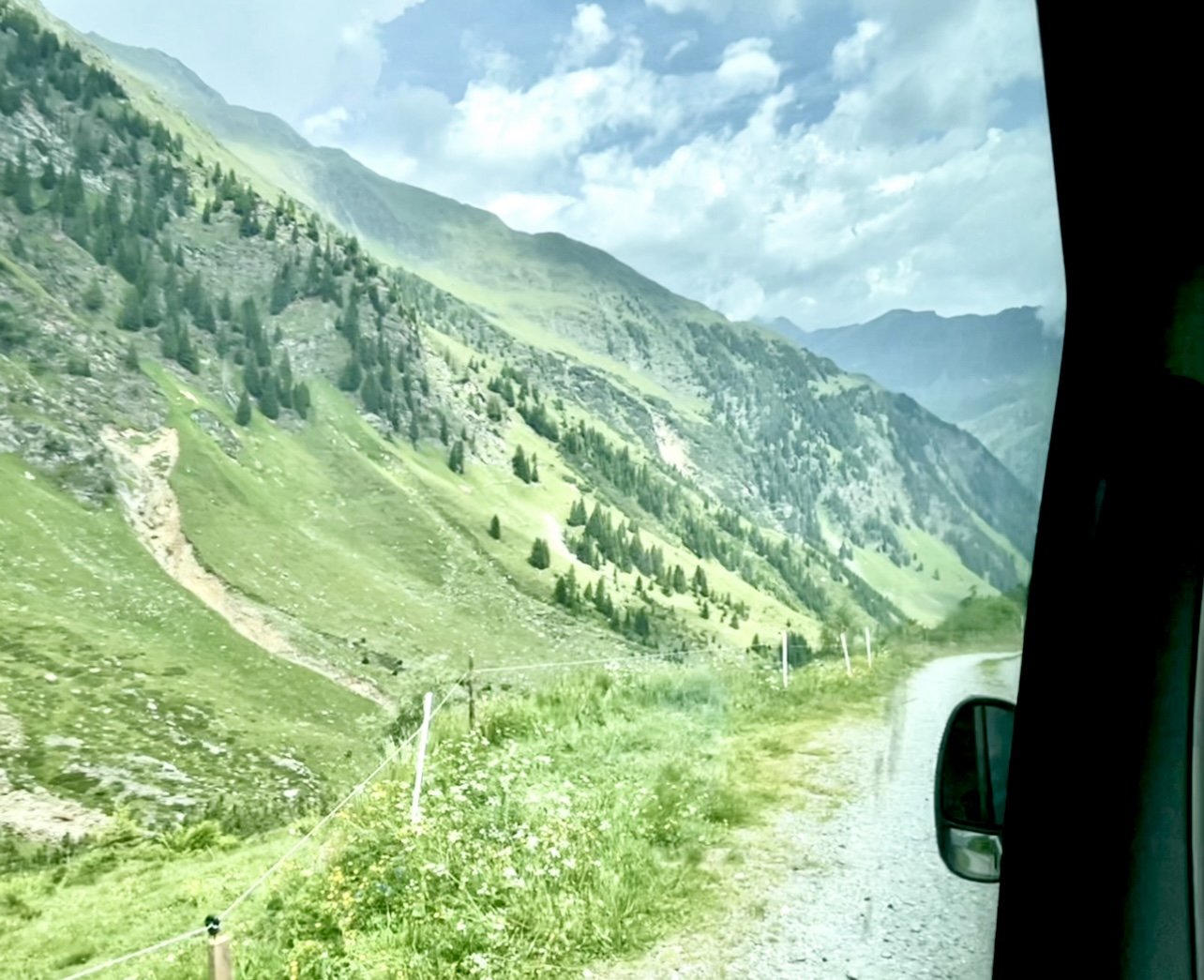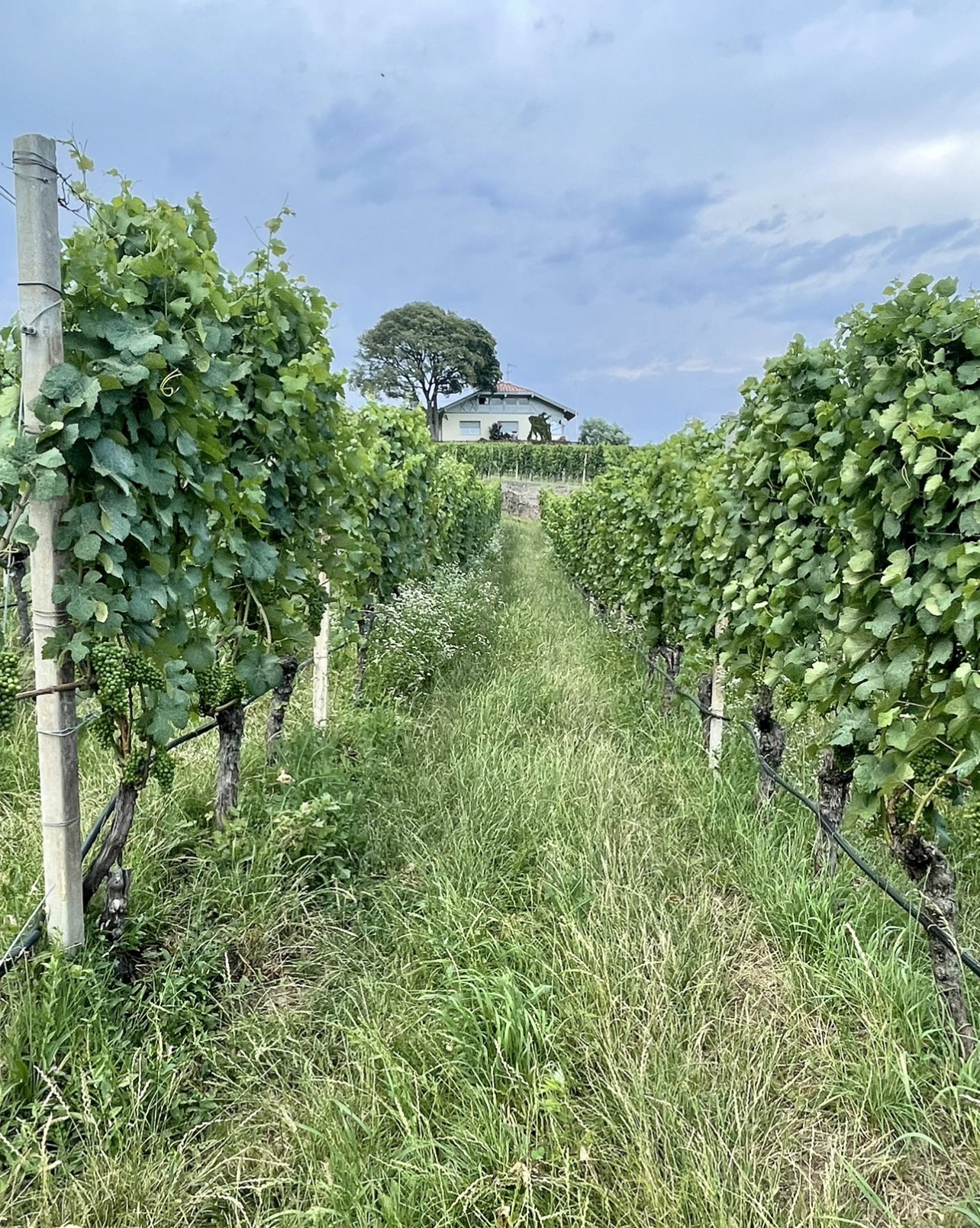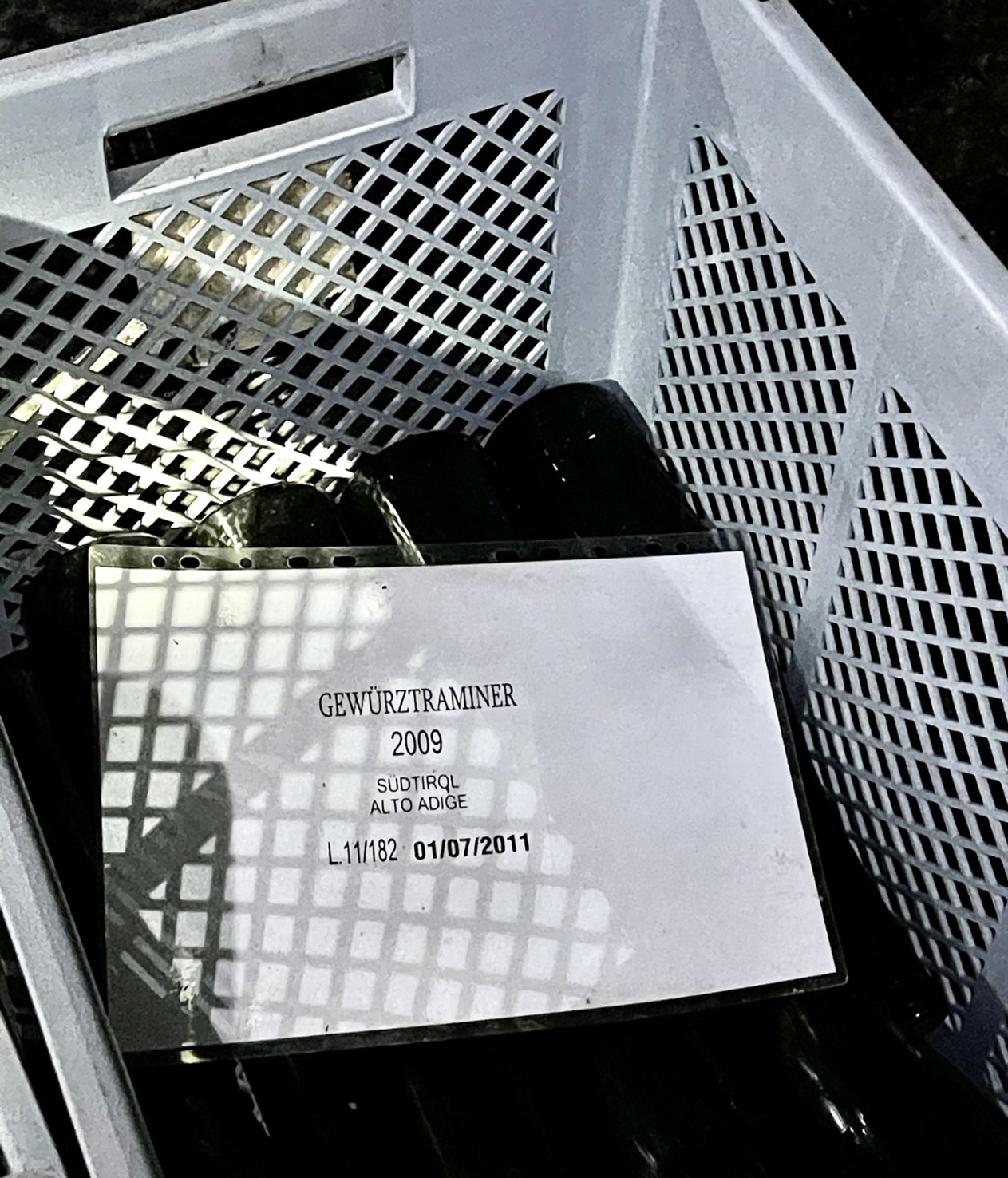Treasures in a Mine: Cantina Tramin’s Epokale Gewürztraminer
/The life of a wine writer, when she’s not alone and hunched over a computer, is full of exciting one-of-a-kind travel experiences. Hiking an active volcano? Check. Off-roading on rough terrain in a New Mexico canyon? Check. Hot air balloons, helicopters, yachts, Humvees, Segways, skis—in the interest of a good story, duty calls and a wine writer climbs aboard.
Yet nothing compares to a recent excursion deep into caves of rocky limestone carved into Italy’s Dolomite mountains hundreds of years ago. The final destination? A defunct silver mine, where some of the world’s most treasured wines lay quietly resting in complete darkness.
Paying a Call to Wine in a Mine
Here’s the lead-up. An early morning start for a group of about 20 journalists at the base of the Dolomites. Safety comes first, so we don full mining gear: helmet with headlamp, miner’s jacket and wellies before boarding a caravan of SUVs that would power up a shoulderless steep and winding dirt road. Thankfully, we arrive safe and sound at the landing, high above sea level in the Ridanna Valley, where a train is waiting to take us on what will be the adventure of a lifetime. And it begins in a narrow, pitch black tunnel.
Peering out the car window On the road to the mine. All photos by Lisa Denning.
I’ll admit, I was feeling some trepidation. What if a deep-rooted claustrophobia was awakened in me? Then what? I had been told the train could only take us so far and, after disembarking, we would be hiking in muddy waters through narrow and wet corridors to reach our destination 4 kilometers deep (2.6 miles) into the mountain.
No time for over-thinking, though, as we set off into the tunnel in a flash, the wheels of the train screeching so loudly I could no longer hear a word spoken by the person sitting across from me. That person was Wolfgang Klotz, Director of Marketing for Cantina Tramin, whose wines we were about to pay a visit to.
In the mine with Wolfgang Klotz.
You do not want to be In these tunnels if claustrophobia kicks in! In Photo At right is Allison Levine of Please The Palate.
A Winery in The Far Northern Reaches of Italy
Cantina Tramin is located in Alto Adige, in the northeast Italian wine region of Trentino-Alto Adige, a part of the larger South Tyrol province. Alto Adige borders Austria to the north, with Trentino to the south bordering Veneto and Lombardy.
Up until the end of World War I, South Tyrol was Südtirol, a part of the Austro-Hungarian empire. Today the area is a wonderful blend of German and Italian culture in which both languages are spoken. Visitors to the area can’t help but notice the Germanic influence found everywhere in this Italian region, starting with the charming Bavarian architecture, and followed by the delicious cuisine, featuring dishes like goulash, wurst (sausages) and horseradish beet dumplings—items you’d be hard pressed to find anywhere else in Italy.
A Typical scene in the village of Tramin.
Cantina Tramin was founded in the little town of Tramin in 1898 by local pastor, Christian Schrott. His idea was to join together a small group of wine growers who would pool their resources and share costs as joint owners of one company.
This way of making wine, as a cooperative, or co-op, was particularly beneficial at the turn of the 20th century, a time of financial hardships during which many small wineries couldn’t have survived on their own. The concept has stood the test of time as today, cooperative wineries are the backbone of wine production in many European regions. In Alto Adige, an area of many small wine growers, 70% of the wine is produced by these member-owned wineries.
Initially, Cantina Tramin, like most co-ops, would pay their growers by the amount of grapes they provided, but today the company pays its 160 family members according to the caliber of the grapes, not the volume. “Over time, the strategy changed,” says Klotz, “as the wine growers improved how they work and the varieties they grow. The focus is now solely on getting quality grapes.”
It helps that Cantina Tramin is blessed with vineyards of near-perfect viticultural conditions.
Situated in the scenic foothills of the Dolomite mountains, the vines are planted on glacial soils of predominantly calcareous clay, gravel and silty loam, considered some of the greatest wine soils in the world, which lend a wonderful minerality and structure to the wines. During the growing season, the warm, Mediterranean-like days (temperatures rose well into the 90s when I was there in June) are contrasted by cool alpine nights, allowing the production of ripe, aromatic wines with a firm backbone of acidity.
Gewürztraminer and Alto Adige, A Love Story
Cantina Tramin is named after the town of Tramin (Termeno in Italian) and produces a wide range of white and red wines from many different grapes, however the variety considered its calling card is Gewürztraminer, a full-bodied, aromatic white grape that is also the showcase white wine of the region.
“The Traminer grape takes its name from the town of Tramin, where the variety originated,” says Scott Clemens at epicurean.com, “‘Gewürz’ is the German word for spicy, hence Gewürztraminer is the name given to the spicier clones of Traminer. The Italians call it Traminer aromatico, which is more to the point, as Gewürztraminer's charm lies in its floral aromatic qualities.”
Gewurztraminer can be enjoyed in a range of styles, including dry, off-dry, medium dry and sweet. Records dating back 200 years show that Gewürztraminer was historically made as a sweet wine. However, today the variety is most often is produced in a dry style. Cantina Tramin’s Nussbaumer is a great example; exuberantly aromatic with floral and tropical fruit notes, yet at the same time, fresh and dry with a great interplay between juiciness, richness and salty minerality.
Read more about a tasting of Gewürztraminer wine on The Wine Chef. Can you guess the favorite wine? Hint: it comes from Alto Adige!
The Magnificent Epokale
Cantina Tramin’s exploratory spirit led the winery to create another style of Gewürztraminer, beginning with the 2009 vintage, similar yet different to the traditional sweet wines of yore. Since its debut, the new wine, Epokale, has been turning heads. Its first vintage, 2009, was awarded 100 points by Robert Parker’s Wine Advocate in 2018, the first Italian white wine to obtain this honor.
“It started with the idea of making another style of Gewürztraminer, different from the fresh and dry styles already being made at the winery,” says Klotz. “The inspiration comes from places like Alsace with their late-harvest Spätlese wines. We wanted an elegant and graceful style, with an abundance of acidity, sugar, structure and concentration of fruit—one that can be aged for a very long time. The 2009 was just the beginning.”
Arrival at the Mine
After a lot of calories burned, we made it to the mine safe and sound, finally laying eyes on vintage-labeled bins that held hundreds of quietly snoozing bottles of Epokale wine. We then learned all the fascinating details of the mine and Epokale’s unique aging process.
“The mine dates back to the middle ages,” said Klotz. “From the 12th century and up until the 1970s, mine workers and their families lived on top of the mountain. A miner’s job was tough but they were well paid and could provide a good life for their families. When machines were invented, the dust in the mines increased and the workers’ health was jeopardized and nobody wanted mining jobs anymore. About 15 years ago, we asked the government to rent the space, and at first they said no, but eventually we got permission to keep the wines there and we are the only ones to do that.”
A Gestation Like No Other
The vines for Epokale grow in two of Cantina Tramin’s oldest Gewürztraminer vineyards (in photo). After harvest, the wine is fermented and aged in steel tanks with the lees for about eight to eleven months. The bottled wine is then taken to the mine where it ages in complete darkness for nearly seven years.
Klotz told me they started bringing the Epokale wine into the mine in 2010 and that there are about 10,000 bottles there at any given time.
“Four or five of us go out to the mines with the truck,” says Klotz, “a 2 hour drive from the winery, and take the wine on the train to a certain point where we then have to bring the wine in and out by hand since the last little piece is where the train does not run.”
Klotz admits that it is a lot of trouble to go through, but says it is worth the effort to bring this special wine to maturity under perfectly consistent conditions: 11 degrees celsius (52 degrees fahrenheit), with 90% humidity.
The Takeaway?
Cantina Tramin is a winery dedicated to making top-notch wines and their team pulls out all stops to make some of Alto Adige’s, and the world’s, most coveted wines. Their commitment to excellence in winemaking clearly shows in the magnificent Epokale wine.
And, for me, a morning in a mine was a morning like no other!
Epokale Vintage Report
With such a relatively new wine in the Cantina Tramin portfolio, the winemaking team is still figuring out exactly what works best for the Epokale. “The mine is an important component of the wine but it’s not the only one,” says Klotz. “Each vintage of Epokale reflects the differences in the weather and in the winemaking.”
Over time, the direction of Epokale is leaning towards less residual sugar, with more freshness and harmony between sugar and acidity. Yet the 2009 is a hard act to follow. The team initially thought it could be too much for consumers—too powerful, too sweet, with too much concentration and richness, so they tried to tone things down for the 2010 vintage. However, 13 years later, they are seeing how beautifully the 2009 has aged; still rich and concentrated but with more balance, elegance and a distinct liveliness.
Cantina Tramin’s winery, where the Epokale tasting was held in June of 2022.
With winemaker Willi Stürz, After visiting the mine.
An Epic Tasting
The day before the visit to the mines, a group of about 60 journalists from all over the world, myself included, gathered at Cantina Tramin’s beautiful winery, with winemaker Willi Stürz in attendance, for a grand tasting of six of the most recent vintages. We were poured the latest release, 2015, and vintages going back to 2009. Only the 2014 was missing as it requires further aging in the mine before release.
Below are brief entries from my tasting notes. My advice? With an annual production of only 1,200 to 3,000 bottles per year, I suggest you scoop up whatever you can find of these delicious and unique Gewürztraminer wines.
As you can see below, each vintage of Epokale has a different level of alcohol and residual sugar, which creates that year’s unique characteristics, but regardless of vintage each and every one shows, to one degree or another, a wonderful harmony between sweetness, freshness, intensity of fruit, and richness of texture.
2009 Epokale - 12.5% ABV with 107 grams per liter residual sugar. A warm vintage. Intensely aromatic, rich and concentrated; big and fairly unctuous with notes of ripe peach and tropical fruits, apricot and lychee. Great acidity; deeply flavored with a very long finish. A very lively wine!
2010 Epokale - 13.5% ABV with 36 grams per liter residual sugar. A cool vintage. On the nose, more restrained fruit compared to the 2009. Very floral with honeysuckle and white orchard fruits. A spicier, leaner style with a good balance between fruit and sugar. Spicy, peppery notes and a bitter finish, characteristic of Gewürztraminer.
2011 Epokale - 14.2% ABV; 30 grams per liter residual sugar. Notes of mint, thyme, rosemary and apricot. Spicy peppery notes with bright acidity and a spicy long finish. Well Balanced.
2012 Epokale - 13.8% ABV; 23 grams per liter residual sugar. The most dry style of all the vintages, and very reminiscent of the Nussbaumer dry Gewürztraminer. Orange peel, citrus, ginger.
2013 Epokale - 12.7% ABV; 46 grams per liter residual sugar. A cooler vintage, somewhat restrained aromatics with less tropical fruit notes and more floral. Very fresh with citrusy sensations (lime and orange) Round with less bitterness on the finish.
2015 Epokale - 12.5% ABV; 55 grams per liter residual sugar. Aromatics of fresh fruits like apple and flowers like rose. Rich with peppery, spicy notes. Richer than the ‘13. Young and fresh; still a bit closed. Best to wait four to five years to drink this one.




































